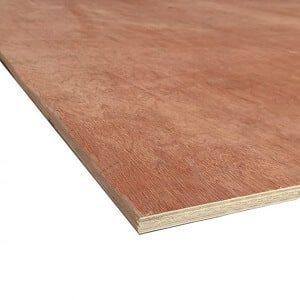How Much Does Marine Grade Plywood Cost?
Last Updated on May 25, 2024
Written by CPA Alec Pow | Content Reviewed by ![]() CFA Alexander Popinker
CFA Alexander Popinker
With its unparalleled structural strength, water resistance, and damage durability, marine grade plywood has become the go-to material for boat builders, pier and dock constructors, and outdoor furniture designers demanding weather-resilient performance. But enhanced capabilities come at a premium cost over conventional plywood sheeting.
Gaining a full understanding of the multitude of variables that influence marine grade plywood pricing allows DIYers, construction pros, boat owners, and architects to budget accurately and get the best value on this specialty wood building product. In this comprehensive guide, we’ll break down the cost drivers, typical price ranges, comparisons between grades and thicknesses, places to purchase, and tips for keeping marine plywood projects affordable.
Whether you’re building boat cabinets or backyard decking to last decades, insight into marine plywood costs empowers you to make the most of every dollar spent. Let’s weigh the true value to make your marine build budget go further.
How Much Does Marine Grade Plywood Cost?
The price per sheet for marine grade plywood generally falls between $100 and $500 per full 4×8 foot sheet, but can vary quite a bit based on thickness, quality grade, special treatments, order volume, and supplier. On the low end, 5-ply sheets 3/8” thick of utility or AB marine grade can cost $100 to $150 per sheet from home improvement stores.
For premium 1” thick AA-grade panels bought in bulk from building materials suppliers, costs are $400 to $500+ per sheet. Most standard construction projects require mid-range 7-ply marine grade sheets 0.6” thick, which run $200 to $300 per sheet at retail lumber yards.
While marine ply demands a higher investment, the unparalleled moisture resistance and decades-long lifespans make it a sound value for marine and outdoor applications. Careful shopping keeps projects on budget.
- 5-ply 0.4” Utility or Marine Grade Sheets: $80 – $150 per sheet
- 7-ply 0.6” Utility or Marine Grade Sheets: $120 – $250 per sheet
- 9-ply 0.8-1.0” Marine Grade Sheets: $200 – $400+ per sheet
Regional cost of living differences can swing prices +/- 20%. Always comparison shop.
Selina Wamucii provides insights into the price of Marine Grade Plywood in the US, stating that a 6-millimetre-thick marine-grade plywood starts at ₹55 per square foot, which is approximately $0.76 per square foot. However, prices are subject to change based on market value.
Woodworkers Source offers Marine Grade Plywood in different thicknesses and sizes. For example, a 1/2″ (12mm) Exterior Marine Grade Plywood Pack is priced at $139.99, while a 3/4″ (18mm) Exterior Marine Grade Plywood Pack costs $179.99. These prices include free shipping within the contiguous US.
Amazon lists various Marine Grade Plywood products with different prices. For instance, a 1/2″ Marine Grade Plywood 24″ X 48″ is priced at $62.30, while a 3/4″ Marine Grade Plywood 24″ x 48″ costs $71.60.
Total Wood Store offers a range of Marine Grade Plywood options, including Baltic Birch Marine Grade Plywood Full Sheets 48″x96″ (4′ x 8′) priced between $82.30 and $233.51, and Hechthout Okoume Marine Plywood Full Sheet 48″x96″ (4′ x 8′) ranging from $125.38 to $327.31. These prices reflect the cost of full sheets of Marine Grade Plywood in different sizes and types.
Shell Lumber and Hardware provides Marine Plywood in various dimensions and thicknesses. For example, 1 In. 2 Ft. x 8 Ft. A.B. Marine Plywood is priced at $91.49, while 1 In. x 2 Ft. x 2 Ft. A.B. Marine Plywood costs $26.99. The store offers a variety of Marine Plywood options to suit different project needs.
Factors That Impact Costs
Quality and Structural Durability Grades – Higher grades designated AA, AB, AC, and Marine feature denser knot-free veneers with enhanced resistance to delamination, checking, and rotting from water absorption. These Superior grades do cost 10-30% more than low-end utility grades, but that extra upfront investment pays off in 5-10X lifespan extension in wet environments. Consider the lifespan cost savings high grades offer rather than just the purchase price.
Panel Thickness and Number of Plys – Thicker 0.8-1.0-inch panels with higher ply counts of 9+ offer substantially greater sheer strength but also 30-60% higher cost per square foot compared to 0.4-0.6-inch 4-5 ply sheets. Choose your desired balance between strength and budget.
Standard Sheet Dimensions vs. Custom Cuts – Full 4×8 foot panels are vastly more affordable than custom cut smaller pieces needed for niche applications. Factor extra cutting fees and material waste into small batch purchases.
Brand Reputation and Manufacturing Quality – Top marine plywood brands like BCX, Midwest Marine, and Greenply leverage advanced proprietary bonding processes and are kiln-dried to minimize defects. Their 20-50% higher prices deliver commensurate boosts in longevity and performance over generic marine plywood.
Special Treatments and Coatings – Special epoxy sealants, closed-cell foam core insulation, aluminum laminate reinforcing, fire retardant resin, and mold inhibitors can significantly enhance panels but also add 10-40% to costs that may not be necessary.
You might also like our articles about the cost of luan plywood, hardwood stair installation, or dry rot repair.
Shipping and Logistics Considerations – Marine plywood sheets weigh 100-200+ lbs., necessitating freight forwarding and professional delivery involving forklifts and lift gates. Shipping costs often equal 20-30% of total price for smaller purchases. Buying locally saves substantially when possible.
Purchase Volumes and Inventory – For one-off purchases, individual retail consumer pricing applies. Bulk purchases of 100+ sheets can qualify for 10-20%+ contractor discounts buying direct from distributors once project volumes justify wholesale price breaks.
Prices for Different Grades and Thicknesses
- Utility Grade 0.4” – $100 per sheet
- Utility Grade 0.6” – $150 per sheet
- DG Douglas Fir 0.4” – $135 per sheet
- DG Douglas Fir 0.6” – $210 per sheet
- AB Marine Grade 0.4” – $145 per sheet
- AB Marine Grade 0.6” – $260 per sheet
- AA Marine Grade 0.4” – $180 per sheet
- AA Marine Grade 0.6” – $320 per sheet
Paying extra for the highest grades earns you exponentially greater lifespan and performance per dollar.
Where to Purchase
 Big Box Retailers – Convenient locations but very limited selection and small on-hand inventory. Usually, Utility or AB at best.
Big Box Retailers – Convenient locations but very limited selection and small on-hand inventory. Usually, Utility or AB at best.
Specialized hardwood retailers – Offer wide grade ranges and ply thickness options but often lack bulk order discounts.
Direct Distributors – The best bet for bulk orders of 100+ sheets, but usually only sell AB/AA grades in full truckload quantities.
Local Yards – Great for small batch purchases with customized sizing while supporting community businesses.
Find suppliers catering to both your unique project needs and budget constraints.
Keeping Marine Grade Plywood Affordable
- Thoroughly compare prices across multiple suppliers before purchasing to find lowest offers
- Buy full 4×8 sheets whenever possible, then have stores custom cut to your project size needs
- Ask about year-end inventory clearance sales as suppliers receive new incoming stock
- For big projects, buy wholesale bulk quantities of 100+ sheets for 15-25% discounts
- Partner with other hobbyists/contractors to purchase together and reach reduced bulk rates on smaller batches
Final Words
Marine plywood commands rightful premiums for its rugged structural enhancements that stand up to decades of moisture, use, and weathering. But armed with inside advice on optimizing grades, dimensions, suppliers, and volumes purchased, your next marine build can enjoy maximized cost-effectiveness without sacrificing quality and longevity.
Frequently Asked Questions
How long does marine-grade plywood last?
With proper construction and maintenance, marine-grade plywood can be expected to last 15-25 years in demanding outdoor and marine environments before signs of delamination, checking, or rot necessitate replacement. Higher quality dense hardwood plys enhance longevity. Regular upkeep also extends lifespans.
Does marine-grade plywood need to be treated?
While some choose to varnish or treat marine plywood for added waterproofing, quality marine-grade plywood is designed to be weather-resistant on its own due to bonded resin adhesives. As long as edges are properly sealed, treatments are optional. Proper construction is more important than coatings.
Can marine ply get wet?
No, getting intermittently wet will not harm marine plywood. It is engineered to withstand constant dampness and periodic water submersion. The resin adhesives resist delamination and deterioration from wetness far better than standard plywood. Just allow the panels to fully air dry to prevent dry rot before fastening.

Leave a Reply
Want to join the discussion?Feel free to contribute!